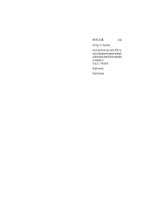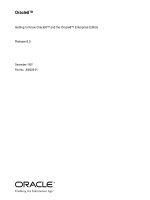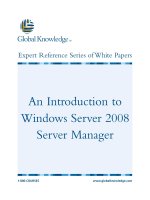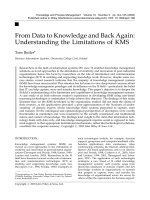Tài liệu Oracle8i Getting to Know Oracle8i pdf
Bạn đang xem bản rút gọn của tài liệu. Xem và tải ngay bản đầy đủ của tài liệu tại đây (1.01 MB, 174 trang )
Oracle8
i
Getting to Know Oracle8
i
Release 8.1.5
February 1999
Part No. A68020-01
Getting to Know Oracle8i , Release 8.1.5
Part No. A68020-01
Copyright © 1999, Oracle Corporation. All rights reserved.
Primary Author: Ruth Baylis, Paul Lane
Contributors: Lance Ashdown, Mark Bauer, D. Yitzik Brenman, Dave Colello, Mary Ann Davidson,
Sandy Dreskin, John Frazzini, Joe Garcia, Michael Hartstein, Thomas Kurian, Lefty Leverenz, Diana
Lorentz, David Mathews, Jack Melnick, Mark Niebur, Tom Portfolio, Den Raphaely, Nasser
Shariatpanahy, Deborah Steiner, Mark Townsend, Randy Urbano, V. Vijayanandan, Steven Wertheimer
Graphic Designer: Valarie Moore
The Programs are not intended for use in any nuclear, aviation, mass transit, medical, or other
inherently dangerous applications. It shall be the licensee’s responsibility to take all appropriate
fail-safe, backup, redundancy and other measures to ensure the safe use of such applications if the
Programs are used for such purposes, and Oracle disclaims liability for any damages caused by such
use of the Programs.
The Programs (which include both the software and documentation) contain proprietary information of
Oracle Corporation; they are provided under a license agreement containing restrictions on use and
disclosure and are also protected by copyright, patent, and other intellectual and industrial property
laws. Reverse engineering, disassembly, or decompilation of the Programs is prohibited
The information contained in this document is subject to change without notice. If you find any problems
in the documentation, please report them to us in writing. Oracle Corporation does not warrant that this
document is error free. Except as may be expressly permitted in your license agreement for these
Programs, no part of these Programs may be reproduced or transmitted in any form or by any means,
electronic or mechanical, for any purpose, without the express written permission of Oracle Corporation.
If the Programs are delivered to the U.S. Government or anyone licensing or using the Programs on
behalf of the U.S. Government, the following notice is applicable:
Restricted Rights Notice Programs delivered subject to the DOD FAR Supplement are "commercial
computer software" and use, duplication, and disclosure of the Programs including documentation, shall
be subject to the licensing restrictions set forth in the applicable Oracle license agreement. Otherwise,
Programs delivered subject to the Federal Acquisition Regulations are "restricted computer software"
and use, duplication, and disclosure of the Programs shall be subject to the restrictions in FAR 52.227-19,
Commercial Computer Software - Restricted Rights (June, 1987). Oracle Corporation, 500 Oracle
Parkway, Redwood City, CA 94065.
Oracle is a registered trademark, and Oracle8, Oracle8i, Oracle8i Lite, Oracle8i Workstation, Oracle Call
Interface, Oracle Enterprise Manager, Oracle Parallel Server, Oracle Advanced Security, Oracle Internet
Directory, PL/SQL, Net8, LogMiner, Pro*C/C++, Pro*COBOL, ConText, WebDB, interMedia, iFS,
SQL*Loader, SQL*Plus, Oracle JServer, Oracle Programmer, and JDeveloper are trademarks or registered
trademarks of Oracle Corporation. All other company or product names mentioned are used for
identification purposes only and may be trademarks of their respective owners.
i
Contents
Send Us Your Comments
................................................................................................................... xi
Preface
.......................................................................................................................................................... xiii
1 Overview
Introducing Oracle8i .......................................................................................................................... 1-2
A Family of Database Products........................................................................................................ 1-4
2 Oracle8
i
New Features
Content Management for the Internet............................................................................................ 2-2
WebDB ........................................................................................................................................... 2-2
Oracle Internet File System (iFS) ................................................................................................ 2-2
interMedia and the Web.............................................................................................................. 2-3
Oracle8i interMedia, Spatial, Time Series, and Visual Image Retrieval.................................. 2-5
Oracle8i interMedia ...................................................................................................................... 2-5
Text .......................................................................................................................................... 2-6
Improved Ease of Use.................................................................................................... 2-6
Extensible Index ............................................................................................................. 2-6
Extensible Query Optimizer......................................................................................... 2-6
Extensible Knowledge Base (KB)................................................................................. 2-7
Filters................................................................................................................................ 2-7
Hierarchical Query Feedback....................................................................................... 2-7
Theme Highlighting....................................................................................................... 2-7
Alternate Spelling........................................................................................................... 2-7
ii
Stoplists............................................................................................................................ 2-7
Field Sections................................................................................................................... 2-7
Audio, Image, and Video ..................................................................................................... 2-8
Summary of Audio, Image, and Video Support........................................................ 2-8
Oracle8i interMedia Audio, Image, and Video Java Client...................................... 2-9
Locator..................................................................................................................................... 2-9
Oracle8i Spatial ........................................................................................................................... 2-10
VARRAY Storage Model .................................................................................................... 2-11
Dynamic Window Queries................................................................................................. 2-11
Spatial Index Mechanism ................................................................................................... 2-11
RELATE() Operator............................................................................................................. 2-11
Extended Functionality....................................................................................................... 2-11
Oracle8i Visual Information Retrieval..................................................................................... 2-12
New Extensible Indexing.................................................................................................... 2-12
Temporary LOB Usage ....................................................................................................... 2-13
Scaling Enhancements ........................................................................................................ 2-13
Proprietary Image Formats ................................................................................................ 2-13
Oracle8i Time Series ................................................................................................................... 2-13
Irregular Time Series........................................................................................................... 2-14
Additional Calendar Frequencies ..................................................................................... 2-14
Flexible Timestamp Precisions .......................................................................................... 2-14
Flexible Patterns................................................................................................................... 2-14
Time Scaling Enhancements .............................................................................................. 2-15
Nested Table Support ......................................................................................................... 2-15
Ease of Use............................................................................................................................ 2-15
Java....................................................................................................................................................... 2-15
Oracle8i’s Java Virtual Machine ............................................................................................... 2-16
JServer Accelerator ..................................................................................................................... 2-16
Programmatic Interfaces............................................................................................................ 2-17
JDBC Drivers ........................................................................................................................ 2-17
Server JDBC Driver ...................................................................................................... 2-17
OCI JDBC Driver .......................................................................................................... 2-17
Thin JDBC Driver ......................................................................................................... 2-18
SQLJ Translator.................................................................................................................... 2-18
Development Models ................................................................................................................. 2-18
iii
Java Stored Procedures....................................................................................................... 2-19
Enterprise JavaBeans........................................................................................................... 2-19
CORBA.................................................................................................................................. 2-19
Utilities and Development Tools.............................................................................................. 2-20
JPublisher.............................................................................................................................. 2-20
JDeveloper ............................................................................................................................ 2-21
loadjava and dropjava ........................................................................................................ 2-21
Data Warehousing and Very Large Data Bases (VLDB)............................................................ 2-21
Summary Management Using Materialized Views .............................................................. 2-22
Transportable Tablespaces........................................................................................................ 2-23
Direct Path Load API ................................................................................................................. 2-24
ROLAP Enhancement: Extended Aggregate Operations..................................................... 2-24
Data Mining: SAMPLE Function.............................................................................................. 2-24
Function-Based Indexes............................................................................................................. 2-24
Descending Indexes.................................................................................................................... 2-25
Enhancements for Bitmap Indexes........................................................................................... 2-25
Parallelization of Aggregate Distinct Queries........................................................................ 2-26
Sort Improvements..................................................................................................................... 2-26
Single-Table Hash Cluster......................................................................................................... 2-26
Data Warehouse Statistics Gathering ...................................................................................... 2-26
Automated Parallel Query Tuning .......................................................................................... 2-27
Statistics Generation for Long-Running Operations............................................................. 2-28
New Constraint Functionality .................................................................................................. 2-28
Constraint Modification ..................................................................................................... 2-28
DISABLE VALIDATE Constraint State............................................................................ 2-28
Index-Organized Tables ............................................................................................................ 2-29
General Enhancements....................................................................................................... 2-29
Logical ROWIDs.................................................................................................................. 2-29
Related Features.......................................................................................................................... 2-30
Database Features ............................................................................................................................. 2-30
Extensibility Framework ........................................................................................................... 2-31
User-Defined Operators and Extensible Indexing ......................................................... 2-31
Extensible Optimizer ......................................................................................................... 2-32
Statistics Collection Functions.................................................................................... 2-32
Selectivity Functions.................................................................................................... 2-32
iv
Cost Functions .............................................................................................................. 2-32
Cartridge Services................................................................................................................ 2-32
Object Relational Enhancements .............................................................................................. 2-33
LOB Enhancements ............................................................................................................. 2-33
Temporary LOBs .......................................................................................................... 2-33
Other Enhancements.................................................................................................... 2-33
User-Defined Object Identifiers......................................................................................... 2-34
Nested Table Enhancements.............................................................................................. 2-34
Varray Enhancements......................................................................................................... 2-35
Collection Unnesting........................................................................................................... 2-35
Enhancement of Object Views ........................................................................................... 2-35
Triggers on Nested Table View Columns........................................................................ 2-35
Object Cache Enhancements.............................................................................................. 2-36
ANALYZE Command, Dangling REFs............................................................................ 2-36
Subqueries in VALUES Clause of INSERT Statement ................................................... 2-36
SQL*Loader Support for Objects, Collections, and LOBs.............................................. 2-36
Other Object Relational Enhancements............................................................................ 2-37
Partitioning of Tables Containing Objects................................................................ 2-37
Parallel Query Support................................................................................................ 2-37
Optimizer Plan Stability............................................................................................................. 2-37
Advanced Queuing .................................................................................................................... 2-37
AQ-Based Publish/Subscribe ............................................................................................ 2-38
Database Event Publication................................................................................................ 2-39
Enhanced Propagation........................................................................................................ 2-39
Miscellaneous Enhancements............................................................................................ 2-39
DBMS_REPAIR Package............................................................................................................ 2-40
Redo Log Analysis Using LogMiner........................................................................................ 2-40
Drop Column............................................................................................................................... 2-41
Locally Managed Tablespaces .................................................................................................. 2-41
Online Index Creation, Rebuild, and Defragmentation........................................................ 2-41
Nonpartitioned Table Reorganization..................................................................................... 2-42
Online Read-Only Tablespaces................................................................................................. 2-42
Temporary Tables....................................................................................................................... 2-42
National Language Support (NLS) .......................................................................................... 2-43
General Enhancements ....................................................................................................... 2-43
v
Changing Character Sets with ALTER DATABASE...................................................... 2-43
TRIM Function ............................................................................................................................ 2-44
External Routines........................................................................................................................ 2-44
The Call Specification ......................................................................................................... 2-44
External Routine DLL Caching ......................................................................................... 2-45
External Routine Object Support ...................................................................................... 2-45
Database Security ....................................................................................................................... 2-45
Partitioning Enhancements............................................................................................................. 2-45
Range Partitioning Enhancements........................................................................................... 2-46
Merging Partitions............................................................................................................... 2-46
Updatable Partition Keys ................................................................................................... 2-46
New Partitioning Methods........................................................................................................ 2-46
Additional Performance Gains................................................................................................. 2-47
Enhanced Partition Elimination ........................................................................................ 2-47
Partition-Wise Join .............................................................................................................. 2-47
Partitioned Table LOB Support ................................................................................................ 2-47
Partitioning of Index-Organized Tables.................................................................................. 2-47
System Management........................................................................................................................ 2-48
Database Resource Management ............................................................................................. 2-48
Recoverability and Availability in the Database.................................................................... 2-49
Multiple Remote Archive Destinations............................................................................ 2-50
Multiple Archive Processes................................................................................................ 2-50
Automated Standby Databases ......................................................................................... 2-50
Automatic Archival...................................................................................................... 2-50
Read-only Databases.................................................................................................... 2-51
Fast-Start Fault Recovery ................................................................................................... 2-51
Fast-Start Checkpointing............................................................................................. 2-51
Fast-Start On-Demand Rollback ................................................................................ 2-52
Fast-Start Parallel Rollback......................................................................................... 2-52
Database SUSPEND/RESUME ......................................................................................... 2-52
Control File Character Set .................................................................................................. 2-52
Recovery Manager (RMAN) ..................................................................................................... 2-53
Recovery Catalog No Longer Required ........................................................................... 2-53
Media Management API, Version 2.0............................................................................... 2-53
Proxy Copy.................................................................................................................... 2-53
vi
Media Pool Selection.................................................................................................... 2-54
Vendor Identification and Improved Error Messages............................................ 2-54
Send Command ............................................................................................................ 2-54
Crosscheck Catalog ............................................................................................................. 2-54
List and Report Commands ............................................................................................... 2-54
Recovery Catalog Maintenance Commands ................................................................... 2-54
CREATE CATALOG.................................................................................................... 2-54
UPGRADE CATALOG................................................................................................ 2-55
DROP CATALOG ........................................................................................................ 2-55
Database Maintenance Commands .................................................................................. 2-55
STARTUP/SHUTDOWN............................................................................................ 2-55
ALTER DATABASE..................................................................................................... 2-55
DUPLICATE Command..................................................................................................... 2-55
Node Affinity Detection ..................................................................................................... 2-55
Backups ................................................................................................................................. 2-56
Duplexed Backup Sets ................................................................................................. 2-56
Naming .......................................................................................................................... 2-56
Will No Longer Be Overwritten................................................................................. 2-56
Performing TSPITR Without A Recovery Catalog ......................................................... 2-56
Backup Performance Views ............................................................................................... 2-56
SQL*Loader Enhancements....................................................................................................... 2-56
Export and Import Utilities ....................................................................................................... 2-57
Operational Simplicity ............................................................................................................... 2-57
Oracle Software Packager and Oracle Universal Installer............................................. 2-58
Oracle Software Packager ........................................................................................... 2-58
Oracle Universal Installer............................................................................................ 2-59
Configuration Improvements............................................................................................ 2-59
Oracle Database Configuration Assistant................................................................. 2-59
Oracle Data Migration Assistant................................................................................ 2-60
Oracle Enterprise Manager (OEM) ................................................................................... 2-60
Oracle Parallel Server....................................................................................................................... 2-61
New Architecture........................................................................................................................ 2-61
Easier System Administration .................................................................................................. 2-62
Diagnostic Enhancements .................................................................................................. 2-62
Oracle Parallel Server Management (OPSM) .................................................................. 2-62
vii
Parallel Server Installation and Database Configuration .............................................. 2-63
Instance Affinity for Jobs........................................................................................................... 2-63
Recoverability and Availability Improvements..................................................................... 2-63
Networking Improvements....................................................................................................... 2-64
Distributed Systems......................................................................................................................... 2-64
Advanced Replication Enhancements..................................................................................... 2-64
Performance Improvements .............................................................................................. 2-64
Internal Apply Packages ............................................................................................. 2-64
Faster Snapshot Refresh .............................................................................................. 2-64
Improved Mass Deployment Support.............................................................................. 2-65
Parameterized Snapshot Deployment Templates ................................................... 2-65
Column Level Snapshot Subsetting........................................................................... 2-65
Offline Instantiation..................................................................................................... 2-65
Improved Security............................................................................................................... 2-66
Replication Manager........................................................................................................... 2-66
Improved Oracle Lite Integration ..................................................................................... 2-66
Heterogeneous Services............................................................................................................. 2-66
Multi-Threaded Service Agent.......................................................................................... 2-67
Improved Management Interface: Fixed Views.............................................................. 2-67
Miscellaneous Improvements............................................................................................ 2-67
Remote Join Enhancements....................................................................................................... 2-68
Networking, Security, and Oracle Advanced Security.............................................................. 2-68
Securing Data in the Oracle Database Server......................................................................... 2-68
Fine-Grained Access Control............................................................................................. 2-69
Application Context............................................................................................................ 2-69
Secure Network Computing Through the Oracle Advanced Security Option ................. 2-70
SSL ......................................................................................................................................... 2-70
RADIUS ................................................................................................................................ 2-72
Integrated Security and Directory Services..................................................................... 2-72
Oracle Wallet Manager................................................................................................ 2-73
Certificate Authority.................................................................................................... 2-74
Oracle Internet Directory ............................................................................................ 2-74
Directory-enabled Oracle Security Manager............................................................ 2-75
Net8 Enhancements.................................................................................................................... 2-75
Service Naming.................................................................................................................... 2-75
viii
Automatic Instance Registration ....................................................................................... 2-76
Connection Load Balancing ............................................................................................... 2-76
Native Authentication on Windows NT.......................................................................... 2-77
Multi-Tier Authentication and Authorization........................................................................ 2-77
Program Interfaces............................................................................................................................ 2-77
PL/SQL ........................................................................................................................................ 2-78
Autonomous PL/SQL Blocks ............................................................................................ 2-78
Invoker Rights...................................................................................................................... 2-78
PL/SQL Bulk Binds............................................................................................................. 2-79
Dynamic SQL in PL/SQL................................................................................................... 2-79
Parameter Passing by Reference........................................................................................ 2-79
PL/SQL Procedures for Supporting REF-based Operations ........................................ 2-79
Monitoring and Analysis of Program Execution............................................................ 2-79
DBMS_TRACE.............................................................................................................. 2-80
DBMS_DEBUG ............................................................................................................. 2-80
DBMS_PROFILER ........................................................................................................ 2-80
Increased Package Body Size............................................................................................. 2-80
Purity Rules Relaxed........................................................................................................... 2-80
Precompiler Enhancements....................................................................................................... 2-81
Pro*C/C++ ........................................................................................................................... 2-81
Pro*COBOL .......................................................................................................................... 2-82
Java Interfaces.............................................................................................................................. 2-83
OCI Enhancements..................................................................................................................... 2-83
DML Returning Enhancements......................................................................................... 2-83
Enhanced Array DMLs....................................................................................................... 2-84
OCI Callback Registrations ................................................................................................ 2-84
OCIDescribeAny Enhancements....................................................................................... 2-84
Asynchronous Event Notification..................................................................................... 2-84
Non-Blocking OCI ............................................................................................................... 2-85
Windows NT Integration........................................................................................................... 2-85
Oracle Application Generator for Microsoft Visual Studio........................................... 2-85
Oracle Objects for OLE ....................................................................................................... 2-86
Microsoft Transaction Server Integration ........................................................................ 2-86
COM Cartridge .................................................................................................................... 2-87
ix
3 Release 8.0 New Features and Options
Partitioned Tables and Indexes........................................................................................................ 3-2
What is Partitioning?.................................................................................................................... 3-2
Greater Control Over Data.......................................................................................................... 3-3
Easy-To-Use Administration ...................................................................................................... 3-3
Improved Data Warehouse Performance ....................................................................................... 3-3
Enhanced Star-Query Processing............................................................................................... 3-3
New Parallel Operations ............................................................................................................. 3-4
Increased Database Size............................................................................................................... 3-5
Improvements for OLTP Applications ........................................................................................... 3-5
Extended Backup/Recovery Subsystem................................................................................... 3-5
Very Large User Populations...................................................................................................... 3-6
Advanced Queuing ...................................................................................................................... 3-6
Parallel Server Improvements .................................................................................................... 3-7
Transparent Application Failover (TAF)................................................................................... 3-8
Improved TP Monitor Support................................................................................................... 3-8
Better Security Administration................................................................................................... 3-9
Replication ........................................................................................................................................... 3-9
Object-Relational Technology........................................................................................................ 3-10
Object Types and Views ............................................................................................................ 3-11
Calling External Procedures From Within the Database...................................................... 3-11
Client-Side Support for Objects................................................................................................ 3-12
Evolution of Relational Environments .................................................................................... 3-12
Development Tools for Object Modeling................................................................................ 3-13
Multimedia Data......................................................................................................................... 3-13
Java................................................................................................................................................ 3-13
Extensibility................................................................................................................................. 3-13
Migration and Interoperability...................................................................................................... 3-14
Other Enhancements........................................................................................................................ 3-14
Index-Organized Tables ............................................................................................................ 3-14
Reverse Key Indexes .................................................................................................................. 3-14
Improved Constraint Processing.............................................................................................. 3-14
Two Character Sets in One Database....................................................................................... 3-15
Miscellaneous Improvements................................................................................................... 3-15
x
4 Oracle8
i
Feature and Option Availability
Options.................................................................................................................................................. 4-2
Features ................................................................................................................................................. 4-4
The V$OPTION Table...................................................................................................................... 4-14
5 Oracle8
i
Documentation
Online Documentation Structure .................................................................................................... 5-2
Printed Documentation and Part Numbers ................................................................................... 5-5
Oracle8i Database Server............................................................................................................. 5-5
Oracle8i interMedia, Spatial, Time-Series, and Visual Information Retrieval Options...... 5-7
6 Deprecated and Desupported Features
Strings of Zero Length Are Not Equivalent To a NULL.............................................................. 6-2
The SELECT Privilege........................................................................................................................ 6-2
Date Format Strings Are Stricter...................................................................................................... 6-2
SERIALIZABLE=TRUE Is No Longer Supported........................................................................ 6-2
Non-Deferred Linking....................................................................................................................... 6-3
Applications Using Oracle6 OCI Libraries ............................................................................... 6-4
Applications Using Oracle7 OCI Libraries ............................................................................... 6-4
Applications Using Oracle8 OCI Libraries ............................................................................... 6-5
Single-Task Linking ........................................................................................................................... 6-5
CONNECT INTERNAL..................................................................................................................... 6-6
Partition Views .................................................................................................................................... 6-6
V6 Compatibility Behavior ............................................................................................................... 6-6
Use of "THE(subquery)" Expression ............................................................................................... 6-7
Server Manager Desupport............................................................................................................... 6-7
The SGADEF File................................................................................................................................ 6-7
LONG Column Support .................................................................................................................... 6-7
The Oracle Security Server and Crytographic Toolkit................................................................. 6-8
Dynamic Views Used for Monitoring Parallel Execution Performance................................... 6-8
Glossary
Index
xi
Send Us Your Comments
Getting to Know Oracle8
i
, Release 8.1.5
Part No. A68020-01
Oracle Corporation welcomes your comments and suggestions on the quality and usefulness of this
publication. Your input is an important part of the information used for revision.
■
Did you find any errors?
■
Is the information clearly presented?
■
Do you need more information? If so, where?
■
Are the examples correct? Do you need more examples?
■
What features did you like most about this manual?
If you find any errors or have any other suggestions for improvement, please indicate the chapter,
section, and page number (if available). You can send comments to the Information Development
department in the following ways:
■
Electronic mail -
■
FAX - (650) 506-7228 Attn: Server Technologies Documentation Manager
■
Postal service:
Oracle Corporation
Server Technologies Documentation Manager
500 Oracle Parkway
Redwood Shores, CA 94065
USA
If you would like a reply, please give your name, address, and telephone number below.
If you have problems with the software, please contact your local Oracle World Wide Support Center.
xii
xiii
Preface
This book is intended to introduce Oracle8i, and to present the new functionality
that it brings. It provides descriptions of new features, options, and enhancements;
and includes feature and option factoring matrixes to identify those features and
options that are available with each specific product configuration (Oracle8i,
Oracle8i Enterprise Edition, or Oracle8i Workstation). It references the
documentation that is available for Oracle8i and identifies deprecated or
desupported features.
This preface contains the following topics:
■
Intended Audience
■
How this Book is Organized
■
How to Use This Book
■
Related Documents
■
Your Comments Are Welcome
xiv
Intended Audience
This book is addressed to anyone who would like to become familiar with Oracle8i.
While it provides an overview of Oracle8i, it is intended to be of particular interest
to those who desire to identify and develop an understanding of its enhancements,
new features, and options.
How this Book is Organized
This book is organized as follows:
Chapter 1, "Overview"
Contains an introduction to Oracle8i.
Chapter 2, "Oracle8i New Features"
Contains summaries of the new features and options, offered in Oracle8i, release
8.1.5. Some additional products that compliment or enhance the functionality of
Oracle8i are also discussed.
Chapter 3, "Release 8.0 New Features and Options"
Because many of the Oracle8i features enhance or extend functionality introduced
in Oracle8, Chapter 3 maintains the summary of Oracle8 features.
Chapter 4, "Oracle8i Feature and Option Availability"
Contains the feature factoring matrixes that present the availability and packaging
of features and options contained in Oracle8i.
Chapter 5, "Oracle8i Documentation"
Identifies Oracle8i documentation.
Chapter 6, "Deprecated and Desupported Features"
Lists the deprecated and desupported features that a user should be aware of when
migrating to Oracle8i.
Glossary
Contains definitions of terms, most of which are new to Oracle8i.
xv
How to Use This Book
Chapter 2, "Oracle8i New Features", can be used to identify a new option, feature,
or enhancement and to read its description. For more information, you may refer to
the documentation that is cross-referenced in the description.
Oracle8i contains a subset of the features and options that are available in Oracle8i
Enterprise Edition and Oracle8i Workstation. You can refer to the matrixes in
Chapter 4, "Oracle8i Feature and Option Availability", to identify if a particular
option or feature is available for your product configuration.
Related Documents
While this book identifies enhancements, new features, and options for Oracle8i,
release 8.1.5, it does not attempt to identify every new or changed initialization
parameter, data dictionary table, view, command, package, or the likes. Such
information should be available from the cross-referenced documentation.
However, some general references for finding such information are:
Oracle8i Migration. For a complete list of all new Oracle8i initialization parameters,
static data dictionary tables, and dynamic performance views
(V$ views). Many initialization parameters have been added,
changed, or dropped in this release.
Oracle8i Supplied Packages
Reference
Any new packages are included in this book or cross-referenced
by it.
Oracle8i Reference This is the complete Oracle8i reference for:
■
Initialization Parameters
■
Static Data Dictionary Views
■
Dynamic Performance (V$) Views
■
Database Limits
■
SQL Scripts
■
Oracle Wait Events
■
Enqueue and Lock Names
■
Statistics Descriptions
Oracle8i SQL Reference This is the complete reference of SQL commands. It identifies all
new Oracle8i commands.
xvi
Your Comments Are Welcome
We value and appreciate your comments as an Oracle user and reader of our
references. As we write, revise, and evaluate, your opinions are the most important
input we receive. At the front of this reference is a Reader’s Comment Form that we
encourage you to use to tell us both what you like and what you dislike about this
(or other) Oracle manuals. If the form is missing, or you would like to contact us,
please use the following address or fax number:
Server Technologies Information Development Manager
Oracle Corporation
500 Oracle Parkway
Redwood Shores, CA 94065
FAX: 650-506-7228
You can also e-mail your comments to the Information Development department at
the following e-mail address:
Overview 1-1
1
Overview
This section presents an overview of the Oracle8i database server and includes the
following topics:
■
Introducing Oracle8i
■
A Family of Database Products
Introducing Oracle8i
1-2 Getting to Know Oracle8
i
Introducing Oracle8
i
Oracle8i, the database for Internet computing, changes the way information is
managed and accessed to meet the demands of the Internet age, while providing
significant new features for traditional online transaction processing (OLTP) and
data warehouse applications. It provides advanced tools to manage all types of data
in Web sites, but it also delivers the performance, scalability, and availability needed
to support very large database (VLDB) and mission-critical applications.
Oracle8i is much more than just a simple relational data store. It introduces iFS, the
Internet File System that allows users to easily move all of their data into an
Oracle8i database where it can be stored and managed more efficiently in an
integrated fashion. A new option, Oracle8i interMedia, allows businesses to manage
and access multi-media data, including image, text, audio, video, and spatial
(locator) data. The interMedia Clipboard and Web Agent work together to
Web-enable interMedia. WebDB is a new HTML-based development tool for
building HTML Web pages with content based on data stored in Oracle databases.
Oracle8i introduces new support for Java by including a robust, integrated, and
scalable Java Virtual Machine within the server. This expands Oracle’s support for
Java into all tiers of applications, allowing Java programs to be deployed where
they perform best—in the client, server, or middle tier—without recompiling or
modifying the Java code.
Not only does Oracle8i introduce significant breakthrough technology, such as a
Java VM and iFS, it also has significant new features and functionality for
traditional OLTP and data warehouse applications. For data warehouses, Oracle8i
now provides sophisticated summary management features to store aggregates that
are commonly queried, reducing query processing significantly.
For OLTP applications, Oracle8i introduces the optimizer plan stability feature
allowing the user to ensure that the optimizer selects the same tuned plan every
time the same query is executed. Advanced Queuing has been enhanced to support
a publish/subscribe paradigm. OLTP applications benefit from the many new and
enhanced features that improve the recoverability and availability of the database
during routine operations, such as index rebuilds, and in disaster situations where a
standby database may be activated.
Oracle8i introduces database resource management where the DBA now has the
ability to control the processing resources allocated to a user or group of users. Two
new partitioning methods, hash and composite, complement the established range
partitioning method to provide a rich set of partitioning methods from which the
DBA may choose the best method to fit an application’s profile and workload.
Introducing Oracle8i
Overview 1-3
The Oracle Parallel Server features a new architecture in Oracle8i. Cache fusion is a
new "diskless" ping architecture that greatly improves inter-instance
communication. New networking features improve the ease of use for OPS and
system administration is made easier through the enhancement of Oracle Parallel
Server Management, the new Oracle Universal Installer, and the Oracle Database
Configuration Assistant.
Oracle8i extends the functionality of advanced replication, focusing on
mass-deployment applications. Data can be replicated to servers that are closer to
users and have only the data those users need, providing better performance.
Security has been improved. The replication manager has been rewritten in Java
and is no longer constrained to run on a Windows-based machine.
While Oracle has expanded its support of multimedia data through interMedia, and
other complex data types through the separately packaged Visual Information
Retrieval, Time Series, and Spatial options, it has also provided a new extensible
architecture for independent software vendors (ISVs) and other developers to
exploit when developing support for new types of data or specialized processing.
There is significant enhancement to Oracle’s object relational technology, and
Oracle8i makes it available in both the standard and Enterprise Edition.
Language improvements for PL/SQL, Pro*C/C++, Pro*COBOL., and the Oracle
Call Interface (OCI) include significant new functionality. National Language
Support also undergoes substantial change, and a new book provides information
on its use.
Fine-grained access control and application context features build row-level
application security into the database, rather than leaving it at the application level.
Stronger security is provided throughout the enterprise by expanding or enhancing
methods of authentication and authorization, centralizing user management, and
supporting standards.
There is greater Windows NT integration in Oracle8i. It provides full, native
integration with MTS in the Windows NT environment. Application development is
made simpler by the Oracle Application Wizard (AppWizard) for Visual Studio,
which provides developers with a GUI tool for creating a Visual C++, Visual
InterDev, or Visual Basic application accessing data in an Oracle database. The
generated code framework will include Oracle Objects for OLE (OO4O) classes for
connectivity and data access to Oracle databases.
Finally, Oracle8i includes Oracle Enterprise Manager, which is the comprehensive
management framework for managing the Oracle database and application
environment. Oracle Enterprise Manager presents an easy-to-use centralized
console, a rich set of management tools, and the extensibility to detect and solve any
A Family of Database Products
1-4 Getting to Know Oracle8
i
problems that may arise. It also includes several administrative applications for
performing day-to-day tasks for databases and applications, such as scheduling
backup routines.
In summary, Oracle8i is designed to access and manage all your data using the style
and infrastructure of the Internet. Oracle8i is the most complete and comprehensive
platform for building, deploying and managing Internet and traditional
applications.
■
It simplifies the development of applications
■
It simplifies the management of Internet content
■
It simplifies the deployment of applications
Oracle8i provides the lowest cost platform for developing and deploying
applications on the Internet.
A Family of Database Products
Oracle8i is available in four standalone versions:
■
Oracle8i, also referred to as the standard edition of Oracle8i, is the basic version
and includes core features for most Windows NT and Unix applications.
■
Oracle8i Enterprise Edition adds several high-end features and options for
mission-critical OLTP and data warehousing applications.
■
Oracle8i Workstation is a single-user development database for Windows NT,
Windows95, or Windows98, that now includes all Enterprise Edition options
and features.
■
Oracle8i Lite is a lightweight mobile Java database that easily synchronizes
laptops and hand held devices with corporate databases. It is not discussed in
this book.
Oracle8i New Features 2-1
2
Oracle8
i
New Features
This chapter describes new features, options, and enhancements available in
Oracle8i.
The following topics are included.
■
Content Management for the Internet
■
Oracle8i interMedia, Spatial, Time Series, and Visual Image Retrieval
■
Java
■
Data Warehousing and Very Large Data Bases (VLDB)
■
Database Features
■
Partitioning Enhancements
■
System Management
■
Oracle Parallel Server
■
Distributed Systems
■
Networking, Security, and Oracle Advanced Security
■
Program Interfaces
Content Management for the Internet
2-2 Getting to Know Oracle8
i
Content Management for the Internet
The Web and the Internet bring many new challenges to organizations. Today’s Web
sites are often a series of Web pages that take too much time and too many human
resources to develop, deploy, and manage. In addition, their infrastructure may not
be stable or robust enough to support mission-critical applications. Everything
necessary to transform data into powerful Internet applications and content-driven
Web sites is included with Oracle8i. It provides a Web development environment
that allows software developers to easily build dynamic, data-driven Web sites with
a standard Web browser and the Oracle8i database.
WebDB
WebDB is an HTML-based development tool for building HTML Web pages with
content based on data stored in the Oracle database. Using a browser-based
interface, Web pages can be created containing reports, charts, calendars, menus,
and forms. WebDB provides build wizards for step by step guidance through the
process of creating these components. The wizards include steps for building the
PL/SQL statement that selects data used in the components, and steps for setting
look and feel attributes of the component such as color and size.
There is no need to know PL/SQL to create a component. Selecting options in the
build wizard guides WebDB to automatically write the PL/SQL code for building
the component.
WebDB also provides a wizard to create a Web site within the Oracle database and
assign a site administrator to control its development of the site. The Web site
administrator in turn assigns owners who are responsible for providing content to
the site. Content can include Web pages containing WebDB components, links to
other URLs, and files uploaded to the Web site.
Once a site is created, it is maintained using options within the site itself. Content
owners and end users never have to see the WebDB user interface. For example, the
look and feel of the site can be updated using options provided within the site. End
users perform searches of the site’s content using options within the site.
For more information, see Oracle WebDB Release 2.0: Getting Started - Installation and
Tutorial.
Oracle Internet File System (
i
FS)
Oracle iFS combines the power of Oracle8i with the ease of use of a file system.
Completely integrated with Oracle8i, the Internet File System is a Java application
Content Management for the Internet
Oracle8i New Features 2-3
that runs within the Oracle8i Java Virtual Machine. It enables the database to
become and Internet development and deployment platform.
Oracle iFS makes it possible to treat the database as if it were simply a shared
network drive. Users can store and retrieve files managed by the database as if they
were files managed by a file server. Because iFS supports a variety of standard
protocols, users have universal access to their data. Whether a user accesses the
contents of iFS through Windows Explorer, a Web browser, an FTP client, or an
e-mail client, the files appear the same.
Not only can relational data appear as files, but hybrid documents that combine
relational and non-relational data into single objects can be created and viewed.
Files and folders in iFs are stored in a repository. They are indexed on content and
file properties, allowing for intelligent text searches and queries.
From a developer’s standpoint, iFS is the single data store containing the data for
many different applications. For the system administrator, iFS provides a single
system for file storage and messaging, rather than several separate systems to
maintain and administer. In short, iFS is a simpler way of storing different types of
files in the database.
inter
Media and the Web
Web applications require advanced data management services that support the rich
datatypes used in Web repository, e-commerce, and other Internet applications.
Oracle8i interMedia adds support that enables the database server to manage
multimedia content, both for Internet and traditional applications that require
access to image, audio, video, text, and location information. Oracle8i interMedia
includes the following:
■
Oracle’s ConText text services, to deliver the powerful text retrieval capabilities
fundamental to Web applications. These services let users query and analyze
documents stored in document archives, online news feeds, customer call
reports, and other online text information sources. Users can query for data in
the most common formats, including HTML, Word, Excel, and Acrobat/PDF
formats.
Note:
For Oracle8i, release 8.1.5, an SDK version of iFS is available
to selected sites, including online documentation. Oracle iFS is
planned for general availability with the next production release of
Oracle8i.









